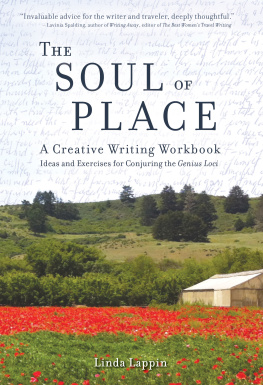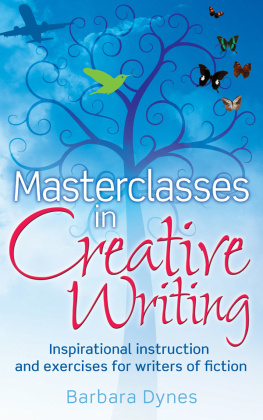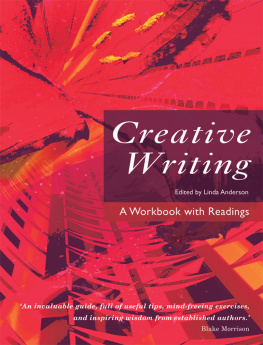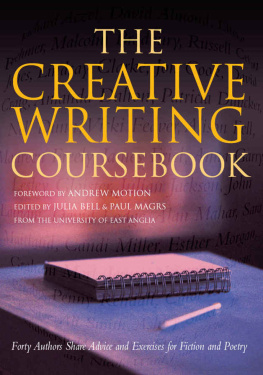

For the writers at Centro Pokkoli
________________________________
Copyright 2015 by Linda Lappin. All rights reserved.
Travelers Tales and Solas House are trademarks of Solas House, Inc. 2320 Bowdoin Street, Palo Alto, California 94306. www.travelerstales.com
Credits and Permissions are given starting on page 228.
Art Direction: Kimberly Nelson Coombs
Cover Photograph: Kimberly Nelson Coombs, farm in Pescadero, California.
Interior Design: Melanie Haage
Interior Photographs: Linda Lappin, pages 4, 10, 87, 177, 203; Sergio Baldassarre, page 64; Arthur Skinner, pages 120, 146
Page Layout: Howie Severson, using the fonts Centaur and California Titling
Production Director: Susan Brady
Library of Congress Cataloging-in-Publication Data
Lappin, Linda.
The soul of place creative writing workbook : ideas & exercises for conjuring the genius loci / Linda Lappin. -- First edition.
pages cm
ISBN 978-1-60952-104-2 (epub) -- ISBN 978-1-60952-103-5 (paperback)
1. Creative writing--Handbooks, manuals, etc. 2. Place (Philosophy) 3. Authorship--Handbooks, manuals, etc. 4. English language--Rhetoric--Handbooks, manuals, etc. 5. Creation (Literary, artistic, etc.) 6. Travel writing--Authorship. 7. Creative nonfiction--Authorship. I. Title.
PE1408
808'.042--dc23
2015017410
Table of Contents
Introduction
H as it ever happened to you to fall in love with a placeyour own neighborhood or an exotic locality glimpsed from a train while on vacation? Theres just something in the atmosphere that has an irresistible appeal compounded of colors, scents, sounds, textures, even the taste of the air. Maybe, taking a wrong turn in a strange city, you have come upon a shady square or a house for sale that captured your imagination, but you cant really say what attracts you so much. That row of yellow bicycles parked by a crowded caf with live music playing, those red geraniums on a windowsill where a sleek, black cat is snoozing and a green shutter is half-open, the chic nonchalance of people passing by with baguettes tucked under their arms? The scene triggers a fantasy in your mind: If you could just move there, something truly interesting would happen, and the story of your life would change.
Perhaps there are cherished locations in your past, the view from a mountain peak, a beach house overlooking a raging surf, or a rocking chair by a fireplace that made you feel content and at peace, or empowered and adventurous. Some places, whether indoors or outdoors, make us feel cozy and safe, inclined to daydreams. Others lift our spirits to unthinkable heights, urging us to go beyond our limits, physical or mental. There are sacred sites that can cause us to weep with remorse and humility, infuse us with joy, even make us feel immortal. Then there are other sorts of places where we become uncomfortable, on edge, oppressed, even panicky, anxious to get out of there quickIf we stay too long, who knows what bad things could happen to us there?
If you have ever had experiences similar to these, chances are that you have been touched by the power of place. This magic manifests itself in familiar as well as foreign territories, in the sublime and in the mundane, in the sacred and profane, at work in cafs, churches, temples, tombs, lighthouses, and fairgrounds. Some anthropologists suggest that our attraction to (or repulsion for) certain places derives from a deep, unconscious attunement to our environment, hearkening back to when we were all nomads, in search of suitable habitats and dependent on our instincts to lead us to water, fertile hunting grounds, or other sources of food. Back then we had a much more visceral response to our universe; we sensed where we were likely to thrive, and where not.
That instinct is not dead in us today, but we may not pay enough attention to it. Perhaps thats because much of our lives, at least in industrialized countries, is played out in what French anthropologist Marc Aug has called nonplaces: those anonymous, deracinated spaces of shopping malls, airports, computer screens that look the same all over the world. Yet the desire to be rooted in or connected to a real place on the earth, a community, a physical world of our own, stems from a very basic human need.
The power of place isnt necessarily life enhancing. It can be threatening or devastating, pulsing with negative and positive charges that may change valence according to our personal point of view. Architects, city-planners, garden-designers, interior decorators, and before them priests, shamans, and geomancers have always known that our environment, external or internal, can be shaped to elicit certain feelings and moods, promote health or sicken us, or encourage certain behavior. They have also been aware that in modeling the landscape or constructing a building they must work with a creative force inherent in the land itself, known in the ancient classical world as the genius loci , usually translated as the soul or spirit of place.
Most people today might define this term as the atmosphere or ambience of a locality or as the emotion or sensation that it evokes in us. To the ancient Romans, instead, it referred to an entity residing in a site and energizing it. In other words, a guardian spirit with its own personality, able to interact with human beings. A more modern conception holds that the genius loci is a composite of climate and landscape together with the cultural markings in a site left by its current residents and those of long ago, who shaped and cultivated its terrain, giving rise to multiple cultural forms adapted to that particular habitat. To the ancient Romans, all this was but an offshoot of the genius loci , whose signature is deposited in everything existing within its range of action, from bodies of water to houses, social customs, patterns of speech, artifacts, recipes, and works of art.
In their religious view, every person, place, or thing concretelike a tree or a stoneor abstractlike love, war, or theatrehad its genius, an in-dwelling spark of divine nature through which that person or thing was created. The genius of an individual (for women, the juno ) appeared at birth and accompanied the person till death. Often represented as a snakeuniversal symbol of time, cosmic energy, and renewalthe genius or juno , similar to the Egyptian Ka , or the Greek daemon , was a sort of spiritual double protecting the health, wealth, development, and success of the person to whom it belonged. The genius loci is specifically the genius abiding in a place.
Volcanoes, fields, villages, temples, public baths, and kitchens all had their genii, who governed and protected the site to which they were attached, determining its atmosphere and influencing the outcome of all events taking place there. If you wanted to build a house or temple in a certain spot, it was customary to seek the blessing of its genius loci or find a way to neutralize any negative influences that might be present there. Similar beliefs in guardian spirits of place have been recorded in such diverse cultures as Africa, Tibet, Australia, Japan, Polynesia, and the American Southwest. Today we might say that the genius loci is a form of intelligence operating within the environment in synergy with human beings.
Writers, poets, and artists, whose job it is to interpret and recreate reality have long been intrigued by the concepts of the genius loci and the power of place. Through different artistic media, they have sought ways to capture the qualities or mood of a location, to find the links between landscape and identity, to show how places can shape our personality, history, and even our fate. At the same time, many literary and artistic movements have tried to illustrate how the outer environments of human beings mirror their inner ones. Writers and artists know that whether we are looking outward or inward at our surroundings, they have a lot to reveal to us about ourselves, our present, past, and future. Consider for a moment a place that you love or hate, or that you feel emanates a power. How would you describe or define its genius loci ? If the soul of place had a voice, how would it sound, what stories would it tell?
Next page











